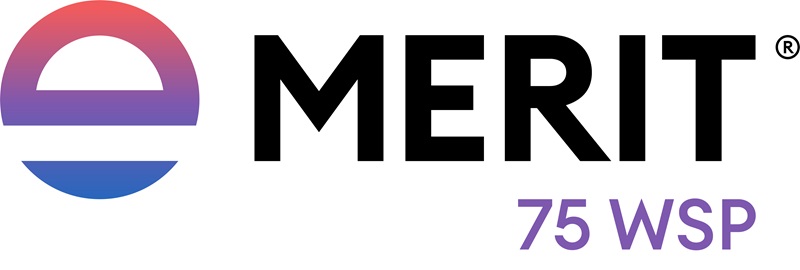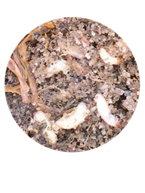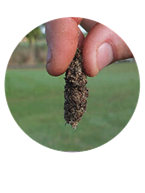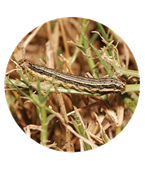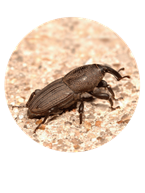The Problem
White grub species include northern and southern masked chafers (Cyclocephala borealis, C. immaculata, C. lurida), Asiatic garden beetle (Maladera castanea), European chafer (Rhizotroqus majalis), May or June beetle (Phyllophaga spp.), Japanese beetle (Popillia japonica), green June beetle (Cotinis nitida) and oriental beetle (Anomala orientalis). Injury to turfgrass occurs from larval feeding on the roots, resulting in infested areas first turning yellow, then brown, and finally dying. When grub populations are heavy, areas of turf can be easily lifted from the soil. In addition, raccoons, skunks, birds and other vertebrate animals feed on white grubs. Turf can be heavily damaged by the activities of these animals as they forage for grubs in infested turf.
What To Look For
The adult beetle stage of white grubs differ in size, color markings and life cycle. The larval stage is similar in appearance and can be characterized by the C-shaped position when found in the soil-thatch interface area of the turf. To identify grub larvae, use a 10X or 20X hand lens and examine the spines on the underside of the abdomen tip, called the raster. The rastral pattern is different for each grub species and is the most common method of identification. The May or June beetle (Phyllophaga spp.) will have a 1 to 3 year life cycle depending on species and geography, while other significant species have a 1-year life cycle.
In most cases, adult emergence occurs in midsummer, often after significant rainfall or irrigation, followed by mating and egg laying. Egg laying can occur at various times during the season, depending on species and region of the country, but usually begins in late June or early July and continues for four to six weeks. The eggs hatch and the small larvae begin feeding on roots with molting from first to second instar occurring in a few weeks. Most of the feeding damage is done by the comparatively large third instar larvae, and it is this stage that causes visible turf damage. Overwintering occurs in this third instar stage with larvae moving downward during late October or November into the soil profile for protection from cold weather. The following spring, these larvae will move up to the soil-thatch interface to feed and replenish food reserves lost during the winter months before moving back down and transforming into the pupal stage. A 1-year cycle will be completed with beetles emerging from this pupal stage a short time later. Monitor beetle activity by establishing black light or pheromone traps in areas that historically have had grub infestations. Japanese beetles may be monitored during the daylight hours using pheromone traps, while chafers and other species require black light monitoring at night. Check these traps at 2 or 3-day intervals, and record and graph collection numbers. Continue trapping until counts start to decline. Larval activity can be expected to occur four to six weeks after peak adult counts.
The Solution
Tetraniliprole, the active ingredient in Tetrino® insecticide, causes immediate feeding cessation upon ingestion, paralysis, and subsequent death, while imidacloprid, the active ingredient in Merit®, interferes with nerve impulses, resulting in insects not feeding and eventually dying. Merit – and especially Tetrino – have sufficient residual activity so applications can be made preceding the egg-laying activity of the adult stage. Tetrino and Merit work best when applied prior to the onset of the third larval stage of white grubs, which in most areas will occur around mid-August. Optimum control is achieved when applications are made prior to egg hatch of the target pests, and when irrigation or rainfall occurs within 24 hours after application to move the active ingredient through the thatch into the soil profile.
The Solution
Cultural management strategies are vital in the prevention of severe nematode damage. Healthy turf with a robust root system can often tolerate nematode feeding with minimal if any damage.
Additional resources
| Solution sheet - White grub - warm season |


